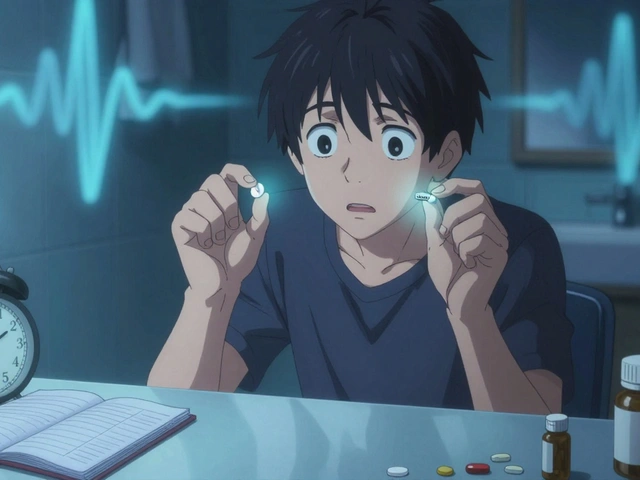Quick Takeaways
- Morr F combines minoxidil and finasteride in one bottle, simplifying daily routine.
- Pure minoxidil (Rogaine) works mainly by widening blood vessels; finasteride (Propecia) blocks DHT production.
- Natural options like saw palmetto and low‑level light therapy have fewer side‑effects but modest results.
- Cost per month: Morr F is mid‑range; separate minoxidil and finasteride can be cheaper or more expensive depending on brand.
- Choose based on tolerance, budget, and how quickly you want visible regrowth.
What Is Morr F?
Morr F is a combined topical hair‑loss solution that blends 5% minoxidil with 0.25% finasteride. It targets two key drivers of male pattern baldness: the hormone dihydrotestosterone (DHT) and reduced scalp blood flow. By delivering both agents in one spray, the product aims to cut down the number of steps in a daily regimen.
How Do the Ingredients Work?
Minoxidil is a vasodilator. When applied to the scalp, it widens tiny blood vessels, boosting oxygen and nutrient delivery to hair follicles. Clinical trials show an average 10‑12% increase in hair count after six months of twice‑daily use.
Finasteride is a 5‑alpha‑reductase inhibitor. It blocks the enzyme that converts testosterone into DHT, the hormone that miniaturises follicles. Studies on oral finasteride (1 mg) report a 25‑30% reduction in hair‑loss progression; the 0.25% topical dose in Morr F delivers comparable scalp DHT suppression with far less systemic exposure.
Why People Consider Alternatives
Not everyone tolerates both drugs. Minoxidil can cause scalp irritation, while finasteride may lead to sexual side‑effects in a small subset of users. Some prefer non‑pharmaceutical routes, either because of concerns about long‑term safety or because they want a more natural approach.

Key Alternatives to Morr F
Below are the most common alternatives, each with its own profile.
- Rogaine - 5% minoxidil solution or foam, used twice daily.
- Propecia - 1 mg oral finasteride taken once per day.
- Saw Palmetto - herbal supplement thought to mildly inhibit 5‑alpha‑reductase.
- Low‑Level Light Therapy (LLLT) - devices such as laser caps or combs that stimulate follicles with red light.
- Platelet‑Rich Plasma (PRP) therapy - injections of concentrated patient’s own platelets into the scalp.
- Nioxin - a shampoo/conditioner system marketed for thinning hair.
Comparison Table
| Product | Active Ingredient(s) | Application | Average Cost / Month (AUD) | Clinical Effectiveness* | Typical Side‑Effects |
|---|---|---|---|---|---|
| Morr F | 5% Minoxidil + 0.25% Finasteride | Topical spray, once daily | ≈ $55 | 30‑35% increase in hair density (6 mo) | Scalp itching, rare sexual symptoms |
| Rogaine (5% minoxidil) | 5% Minoxidil | Topical foam, twice daily | ≈ $40 | 10‑12% increase in hair count (6 mo) | Dryness, irritation |
| Propecia (1 mg finasteride) | Finasteride 1 mg | Oral tablet, once daily | ≈ $45 | 25‑30% reduction in hair loss (12 mo) | Decreased libido, erectile issues (≈ 2%) |
| Saw Palmetto | Extract of Serenoa repens | Oral capsule, 2× daily | ≈ $25 | 5‑8% improvement (mixed studies) | Generally mild GI upset |
| LLLT devices | Red‑light (630‑660 nm) | Cap or comb, 3‑weekly | ≈ $150 (device cost amortised) | 12‑15% increase in thickness (12 mo) | None reported |
| PRP therapy | Autologous platelet concentrate | In‑office injections, 3‑4 sessions/year | ≈ $500 per session | 20‑30% hair‑follicle regeneration (6‑12 mo) | Minor pain, bruising |
How to Choose the Right Option
Consider three practical factors:
- Tolerance. If you’ve had scalp irritation with minoxidil, a lower‑dose combo like Morr F or a non‑topical route may feel better.
- Budget. A one‑time PRP series can be pricey, while a generic minoxidil bottle is cheap. Morr F lands in the mid‑range, offering two actives for a single price.
- Speed of results. Oral finasteride often shows noticeable slowdown of loss within 3‑4 months; minoxidil takes longer to grow new shafts. Combining them, as Morr F does, usually yields the fastest visible thickening.
For most men with early‑stage thinning, starting with Morr F provides a balanced approach: potent DHT suppression, improved scalp circulation, and simple once‑daily use. If side‑effects arise, you can split the regimen (minoxidil alone + oral finasteride) or shift to a natural supplement while monitoring results.
Potential Pitfalls & How to Avoid Them
- Inconsistent use. Hair‑loss drugs need steady exposure. Missing more than two days a week can blunt effectiveness.
- Wrong application area. Apply only to the affected scalp, not the face or neck, to limit systemic absorption.
- Skipping medical check‑up. Because finasteride influences hormone pathways, a baseline PSA test is wise, especially for men over 40.
- Expecting overnight miracles. Visible regrowth typically appears after 12‑16 weeks; patience is key.
Frequently Asked Questions
Can I use Morr F if I’m already on oral finasteride?
It’s generally unnecessary and may increase the risk of side‑effects. Talk to your doctor about switching to the topical combo or adjusting the oral dose.
How long should I wait before seeing results?
Most users notice reduced shedding within 8‑12 weeks and measurable thickening after 4‑6 months of consistent use.
Is Morr F safe for women?
Finasteride is not recommended for women of child‑bearing age due to potential birth‑defect risks. Women may use minoxidil‑only products under medical guidance.
Do I need a prescription for Morr F?
In Australia, the combination is classified as a prescription‑only medicine. You’ll need a doctor’s script or an online telehealth consult.
How does Morr F compare to PRP therapy?
PRP offers a higher one‑time cost but can boost follicle health dramatically for some patients. Morr F is cheaper long‑term and works at the hormonal level, while PRP focuses on growth‑factor signaling.
Next Steps
If you decide to try Morr F, schedule a brief appointment with your GP or a dermatology tele‑service. Get a baseline scalp assessment, confirm no contraindications, and ask for a prescription. Remember to track progress with photos every four weeks - it’s the best way to see whether the combo is delivering the promised regrowth.
Alternatively, if cost or side‑effects are a deal‑breaker, start with a generic minoxidil solution while you explore natural supplements like saw palmetto or a low‑level light device. Whichever route you choose, consistency and realistic expectations are the real secret to keeping more hair on your head.









Nikita Shue
Yo, if you’re sick of juggling a bottle of minoxidil and a pill of finasteride, Morr F is the shortcut you’ve been hunting for. One spray a day hits both DHT and blood flow, so you can finally stop the morning roulette of multiple products. I’ve seen mates who stuck to the combo and actually noticed less shedding within two months. The routine simplicity alone keeps you from skipping doses, which is the biggest win. Give it a shot, stay consistent, and watch the confidence climb.
Ryan Spanier
It is essential to acknowledge that adherence remains the cornerstone of any pharmacologic hair‑loss regimen. Clinical data demonstrate that even modest daily exposure yields measurable follicular density over six months. Therefore, when selecting Morr F, ensure you apply the spray precisely to the affected scalp region once each evening. Concurrently, schedule a baseline PSA test if you are over forty, as recommended by dermatology guidelines. Maintaining a photographic log every four weeks will provide objective evidence of progress, reducing uncertainty.
Abhinav Moudgil
The synergy of vasodilation and androgen blockade in a single topical medium offers a compelling pharmacodynamic narrative. By delivering 5 % minoxidil alongside 0.25 % finasteride, Morr F orchestrates both nutrient influx and DHT suppression without systemic exposure. Such a formulation aligns with the principle of “dual‑action” therapies that have permeated contemporary dermatologic practice. Moreover, the reduced irritation profile compared to separate applications is a noteworthy merit for sensitive scalps. In sum, the product exemplifies a thoughtfully engineered bridge between efficacy and tolerance.
Peter Rupar
This whole “combo spray” hype is just a cash‑grab scheme, and people definetly don’t realize the hidden risks. They push it like it’s a miracle while ignoring the fact that even a tiny amount of finasteride can mess with your hormones. If you care about your health, stop buying into the marketing garbage. Real men rely on proven methods, not some gimmicky bottle.
bill bevilacqua
Well, I gotta say, the idea of slapping a two‑in‑one solution on your head, , , sounds convenient, , , but does it really outperform the cheap generic alternatives?, , , the savings might be negligible, , , and the side‑effects could stack up, , , so think twice before you hand over your hard‑earned cash.
rose rose
Morr F is just a marketing gimmick.
Emmy Segerqvist
Oh my god!!! This combo spray is like a fantasy come true for those desperate for instant hair miracles!!! But beware, the journey is long, the patience thin, and the results often flirt with disappointment!!!
Grace Baxter
While the pharmaceutical industry proudly touts Morr F as the ultimate convenience, one must scrutinize the underlying premise that more chemicals automatically translate to superior outcomes.
The notion that a minoxidil‑finasteride hybrid can outstrip the rigorously studied monotherapies is, at best, an extrapolation that ignores the nuanced pharmacokinetics of topical finasteride.
Moreover, the empirical evidence for topical finasteride’s DHT suppression remains scant, relying on small pilot cohorts rather than the robust, double‑blind trials that oral preparations have amassed over decades.
From a nationalist perspective, it is disconcerting to see domestic consumers being nudged toward imported combos instead of supporting home‑grown botanical alternatives that have stood the test of time.
Saw palmetto, pumpkin seed extract, and even traditional scalp massages embody low‑risk, culturally resonant strategies that align with the country’s heritage of natural remedies.
Critics argue that these “natural” options suffer from modest efficacy, yet the comparative risk–benefit calculus often tilts in their favor when adverse sexual side‑effects are considered.
It is also worth noting that the pricing model of Morr F, positioned at a mid‑range bracket, subtly coerces patients into a false economy-paying more for convenience while forfeiting the ability to titrate each component individually.
If you were to separate minoxidil and finasteride, you could fine‑tune dosages, monitor side‑effects more precisely, and potentially reduce overall expenditure.
The regulatory landscape in Australia classifies the combo as prescription‑only precisely because of these safety concerns, a fact that seldom receives due emphasis in glossy advertisements.
While photobiomodulation devices such as low‑level light therapy lack the injectable mystique of PRP, they offer a drug‑free avenue that circumvents hormonal interference altogether.
In the grand tapestry of hair‑restoration, one should not relegate the century‑old practices of scalp hygiene, nutrition, and stress management to the periphery of conversation.
Indeed, the most consequential determinant of follicular health remains systemic well‑being, a variable that no spray can directly amend.
Consequently, adopting Morr F without addressing lifestyle fundamentals may yield fleeting aesthetic gains but falters in sustaining long‑term regrowth.
The critical takeaway, therefore, is not to denounce the product outright, but to demand rigorous, head‑to‑head comparisons that factor in cost, safety, and cultural relevance.
Until such data emerge, the prudent consumer would diversify their approach, integrating modest pharmacologic aid with proven natural adjuncts.
In short, the hype surrounding Morr F should be tempered with a healthy dose of skepticism, reflective of both scientific rigor and national pride in indigenous solutions.
Eddie Mark
Honestly, it’s kinda cool that you can ditch the two‑step routine and just spritz once a day. The combo feels like a laid‑back hack for guys who don’t want to fuss with pills. As long as you keep the scalp clean and stay consistent, the results can be pretty decent. Just remember, no magic, just steady effort.
Bradley Allan
Listen up, folks!!! The market is flooded with quick‑fix promises, and Morr F is just another glittering siren that lures the unsuspecting!!! It dazzles with convenience, but beneath the sparkle lies a cocktail of potent hormones that can mess with your mojo!!! Don’t be fooled by glossy ads; demand transparency and real‑world evidence before you pour money into this hype!!! Your scalp deserves better than a flashy spray.
Kyle Garrity
I hear the concerns about side‑effects, and that’s completely valid. A balanced approach-starting with a low‑dose spray and monitoring any irritation-can alleviate a lot of the anxiety. Keep a simple journal of shedding patterns and any changes you notice; it often clarifies whether the product is truly helping. If you ever feel uneasy, reach out to a dermatologist for personalized guidance. Remember, you’re not alone in this journey, and steady patience usually pays off.